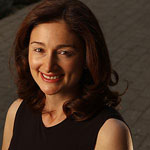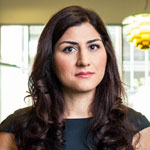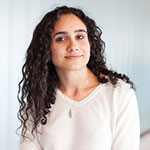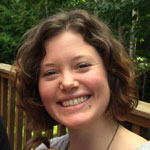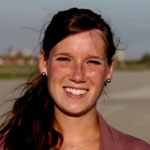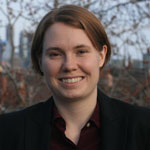A new startup from PhD candidate Rehman Merali (UTIAS PhD 1T5) enables tea-lovers to make a personalized cup of tea from a beverage-weilding robot in under 30 seconds.
“It’s not just a great cup of tea, it’s also the experience,” said Merali, who co-founded teaBOT with his childhood friend, Brian Lee. “You see each ingredient fall down, the water temperature at exactly what you specified, watching the cup of tea made before your eyes.”
 The team launched a prototype in 2013 through Rotman’s Creative Destruction Lab, and is now part of the JOLT business incubator at the MaRS Discovery District.
The team launched a prototype in 2013 through Rotman’s Creative Destruction Lab, and is now part of the JOLT business incubator at the MaRS Discovery District.
The teaBOT kiosks target high-traffic urban locations where tea lovers need a quick on-the-go cup. Using the company’s app, customers can order a customized blend, choosing from 18 loose-leaf teas, and collect their specialized hot beverage in under 30 seconds.
The project has been piloted at the downtown campus, Harry Rosen stores and at the MaRS Discovery district. In December, the team launched an ecommerce site that lets customers reorder their blends to drink at home.
According to the startup’s business manager, next on the development list are “tap to pay” capabilities, adjustable water temperature and new locations around university campuses, transit hubs and malls.
For Merali, the business model is unique, in part because of its capacity for personalization.
“It’s up to the user’s imagination to create those blends and share them with their friends and family,” he said. “Then, they get to try something special that you’ve created for them.”
Entrepreneur Francis Shen (UTIAS MASc 8T3), an alumnus of the University of Toronto Institute for Aerospace Studies, recently established a new entrepreneurial incubation program at the Institute called UTIAS Start, which backed teaBOT with a grant of $25,000 in February.
“The program was set up to encourage and facilitate UTIAS students to utilize the knowledge they have gained through their education and life experience to create business startups and teaBot is a great example,” said Shen. “The leadership team is passionate and resourceful and have a deep understanding of their core market – tea.”
“They are using technologies to revolutionize something quite traditional.”
This March 21 and 22, more than 250 students from across Canada will converge on the Metro Toronto Convention Centre for the annual Women in Science and Engineering (WISE) National Conference—an inspirational weekend to build leadership skills, increase confidence in careers and boost involvement in research and technology-related professions.
“We encourage everyone who’s passionate about science and engineering, and its applications, to attend,” said Mahsa Nami (ChemE 1T4 + PEY), a chemical engineering student and this year’s conference chair. High school students are also welcome, part of WISE’s mandate of motivating young people to join science and engineering fields.
With a growing interest in entrepreneurship at universities and in industry, the theme of this year’s conference is ‘build your own legacy‘.
Industrial engineering student Areeba Zakir (IndE 1T6), who leads WISE’s high school outreach, said the theme connects what people do now to their future, and “motivates you to do something better than just average.”
Some of this year’s keynote speakers include:
- Anne Sado (IndE 7T7), U of T Engineering alumna and president of George Brown College;
- Karl Martin (EngSci 0T1, ElecE MASc 0T3, PhD 1T0), Engineering alumnus and founder of Bionym, creators of the Nymi wristband;
- Cynthia Goh, director of the Impact Centre at the University of Toronto; and,
- Diane Freeman, professional engineer, Councilor for the City of Waterloo and senior manager at Conestoga-Rovers & Associates.
The conference also involves a social innovation case competition where small teams will have two days to create collaborative solutions to a design challenge. To win the $1,000 cash prize, groups will have to propose a design that meets the needs of a specific target market.
Also on the roster are casual fireside chats with mentors, poster and case competitions, a team-building workshop, networking sessions, a career fair and two industry-based sessions hosted by Accenture and General Electric.
Community outreach in STEM
The National Conference is not the only way WISE inspires and supports students all across Canada. Founded in the late 1990s at the University of Toronto, the organization now has local chapters at the University of British Columbia, University of Calgary, University of Ottawa and Carleton University, among others.
WISE’s U of T Chapter leads outreach activities to attract more young women into science and engineering around the Greater Toronto Area, including:
- Visiting local high schools, where student volunteers share their experiences and discuss various programs at U of T;
- Organizing Take Your Kid to Skule Day, an opportunity for high school students to attend lectures and tutorials at U of T.
- Participating at the Science Expo in February; and,
- Joining the one-day public outreach program Science Rendezvous this summer.
“We do a lot of hands-on activities to show children and youth just a small version of some challenges or problem-solving skills that engineering students use,” said Zakir. “It feels great when people come back to you and say, ‘I’m choosing engineering because you told me about your experience.’”
Tickets to this year’s WISE National Conference can be purchased online for $100, and U of T offers 60% reimbursement to its students who attend. Various other universities also offer reimbursements to students.
Leading up to International Women’s Day on March 8, U of T Engineering is celebrating some of our remarkable female alumni, students and faculty. These women are inspirational role models who are “making it happen” in engineering and beyond.
U of T Engineering’s award-winning faculty are passionate about making an impact through innovations in enabling technologies, bioengineering, sustainability and information and communications technology. With expertise at the cutting edge of engineering research, they are also uniquely poised to share their knowledge with the next generation and make a positive impact on the world.
Meet four U of T Engineering female faculty who are pushing boundaries in their field, and inspiring students to do the same.
Jennifer Drake (CivE): Managing the impact of a rainstorm
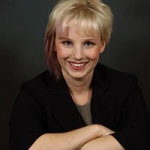 In the concrete jungle of most large cities, a major rainstorm can have a devastating impact on infrastructure. With few natural places to be absorbed, water can flood subway tunnels, cause sewage back-ups and submerge basements.
In the concrete jungle of most large cities, a major rainstorm can have a devastating impact on infrastructure. With few natural places to be absorbed, water can flood subway tunnels, cause sewage back-ups and submerge basements.
Professor Jennifer Drake is an expert in low-impact urban development whose approach to storm water run-off involves distributed management. This means that the run-off is handled through various stages, including green roofs, permeable pavement and bio-retention systems.
“During a storm, green roofs absorb and filter water, reducing strain on the sewage system and restoring some natural stages of the rain cycle, like evaporation and transpiration,” says Drake. “Toronto is a leader in this aspect of storm water management, but green roofs are just one part in a large, integrated system.”
Drake says Toronto’s infrastructure is designed to manage storm-water run-off through a traditional approach called an end-of-pipe system in which all storm water run-off is managed at the end of the pipeline. This is very different from how excess water is absorbed in nature and can lead to increased costs for urban centres and damage to the environment.
Realizing the inadequacy of the traditional approach, governments both locally and internationally are shifting towards integrated water management—a vital change to protect our natural and urban environments, she says.
“We’re moving away from one-size-fits-all solutions when developing infrastructure, and starting to think holistically about our cities and systems.”
Learn more about Jennifer Drake.
Deepa Kundur (ECE): Securing our power supply
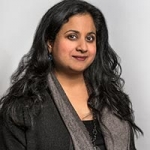 When North America experienced a widespread power blackout in 2003, people became acutely aware of how much modern society relies on electricity. Getting to and from work on public transit, keeping food fresh, heating or cooling our homes—all are powered by complex power grids that are critical to our daily existence and quality of life.
When North America experienced a widespread power blackout in 2003, people became acutely aware of how much modern society relies on electricity. Getting to and from work on public transit, keeping food fresh, heating or cooling our homes—all are powered by complex power grids that are critical to our daily existence and quality of life.
Professor Deepa Kundur’s research aims to secure this vital piece of infrastructure.
As a professor and researcher in The Edward S. Roger’s Sr. Department of Electrical and Computer Engineering, she works with utilities and industrial partners to identify potential vulnerabilities—such as the possibility of a cyber attack—and applies that knowledge to prevent power grids from being compromised through a security breach.
“What we are looking at is securing the communication, decision-making and computation for future power grids,” she says. “We have identified that vulnerabilities exist in the system and we are focused on strategies to help improve the resilience of the system.”
An engineer since 1993, Kundur was a professor at U of T from 1999 to 2002 and then spent 10 years in the United States before returning to U of T in 2012. She began her research into the security of power grids in 2010.
The vulnerability of power grids to cyber attack is very real, she says. Most of North America’s power flows through a small number of transformers and too much knowledge about this infrastructure in the wrong hands could have devastating consequences.
“The power grid is considered one of the greatest engineering feats of humanity and now that we are depending more in information technology, this produces vulnerabilities in the information system,” she says. “So we need to protect that, to protect the economic and overall welfare of society.”
Learn more about Deepa Kundur.
Keryn K. Lian (MSE): Engineering the wearable battery
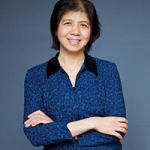 When Keryn Lian was working for Motorola, she had a nagging sense that cell phone batteries had serious deficiencies—and that she should develop a better source of energy.
When Keryn Lian was working for Motorola, she had a nagging sense that cell phone batteries had serious deficiencies—and that she should develop a better source of energy.
Fast forward 12 years and the associate professor in the Department of Materials Science & Engineering has scoped out a niche area of research: developing an energy storage device that is more powerful, smaller, lighter, safer and more flexible than a regular battery.
The key difference is the type of capacitor that is used to help the device charge and store energy. In regular capacitors, the electrolyte that enables the flow of electrical energy is a liquid; in Lian’s device, it is a solid.
Lian’s solid electrochemical capacitor has myriad advantages over other similar energy storage devices. For one, there is no worry of fluid leaking and possibly causing corrosion or fire. Another advantage is that it does not have to be encased in a container, so it can be smaller, lighter and bendable. These properties open up entirely new uses in the everyday world, she says, including applications for the growing printed electronics and “wearables” industry where the device can be attached to clothes and accessories like watches.
“The wearables industry is getting much bigger now in the area of senior care for example,” she says. “They all need power, and hopefully it is seamless to them so that it is contained in a device but attached to something that is comfortable, like clothing.”
Lian’s Flexible Energy and Electronics Laboratory is also working on combining the energy storage device with energy-generating solar cells to form a “self-powered” energy system.
Solar cells can’t store energy, so when the sun goes into hiding, the cells can’t generate more electricity. Lian’s battery can be attached to solar cells, so that when these cells capture energy from the sun, they can charge the battery.
The end result is an extremely clean, renewable source of energy with almost unlimited potential.
Learn more about Keryn K. Lian.
Emma Master (ChemE): Harnessing the power of plants to replace plastic
 It is hard to imagine a world without plastic. Car bumpers, computers, drink containers, even industrial piping and vinyl siding—plastic is practically everywhere.
It is hard to imagine a world without plastic. Car bumpers, computers, drink containers, even industrial piping and vinyl siding—plastic is practically everywhere.
But plastic derived from petrochemicals is also a huge environmental issue, contributing to our carbon footprint, depleting natural resources and building up as non-biodegradable waste in landfills. Recycling helps, but because plastic can only be melted down and reformed so many times, it’s not a permanent solution.
Professor Emma Master is tackling this big challenge, working with her colleagues to develop alternatives to petroleum-based materials like plastic that are both sustainable and environmentally friendly—and they are looking to nature for help.
As a key researcher with U of T’s BioZone, a centre for applied bioengineering research that is led by Professor Elizabeth Edwards and funded by the Canada Foundation for Innovation, Master is working with plant biomass, a renewable, naturally occurring source of diverse and valuable materials to build materials that can replace plastics made from petrochemicals.
“When we tailor them with enzymes, which are proteins that naturally take part in building up and breaking down biomass, we can synthesize a variety of new materials, including ones with plastic-like properties.”
Masters says plastic features prominently in this world for good reason: it has many uses and is durable.
“However, it is clear that our well-being now depends on learning how to harness the unique chemistry that lies above ground, in renewable plant resources. And that’s precisely what we aim to do.”
Learn more about Emma Master.
Leading up to International Women’s Day on March 8, U of T Engineering is celebrating some of our remarkable female alumni, faculty and students. These women are inspirational role models who are “making it happen” in engineering and beyond.
Whether it’s combatting climate change, enhancing biomedical technologies or improving urban infrastructure, engineers are solving global challenges and making a positive impact on our world.
Approaching these problems often requires diverse perspectives and multidisciplinary collaborations. And yet, as of 2013, women accounted for just 11.7 per cent of all professional engineers in Canada.
At U of T Engineering, we celebrate the diversity of our students. With 30.6% female first-year enrolment—the highest in Ontario—we are proud to share the successes of our remarkable students as they continue to inspire each other and enrich our culture of excellence.
Here are 10 students, selected by their departments for their academic and co-curricular achievements, who share why they chose engineering, and why it’s the perfect fit.
Chandini Chandrabalan (ECE 1T7)
 In high school, many of Chandini Chandrabalan’s math and physics teachers discouraged her from engineering because they thought it would be too difficult. But Chandrabalan wasn’t deterred. Her interest in sustainability technologies led her to a degree electrical and computer engineering.
In high school, many of Chandini Chandrabalan’s math and physics teachers discouraged her from engineering because they thought it would be too difficult. But Chandrabalan wasn’t deterred. Her interest in sustainability technologies led her to a degree electrical and computer engineering.
“Whenever you’re passionate about something, there’s nothing really that can stop you,” she said.
Now Chandrabalan volunteers as a mentor to other students.
“I always tell them the technical things like math – that’s something you can learn. If you’re a logical thinker, you’re creative by nature and you have a critical eye for the world around you, that’s something inherent within you, and not necessarily something you can learn.”
“Students considering engineering: look within yourself and think about how you learn and what you like doing. It’s not necessarily about whether you’ve played with a circuit board or if you’re not keen on computers. Stuff like that can always come later.”
Chandrabalan says it’s particularly important that women participate as engineers.
“We are literally half of the population,” she said. “Engineers are at the forefront of how society operates.”
Marina Curak (MechE 1T6)
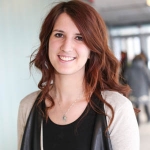 For Marina Curak, the decision to go into engineering came at the last minute, even though she had always loved science.
For Marina Curak, the decision to go into engineering came at the last minute, even though she had always loved science.
“Initially I was applying to all business programs. That’s what my parents wanted me to do,” she explained.
She applied to engineering just in case and, in the end, decided that was what she truly wanted to do. Curak’s older sister, who was studying civil engineering at U of T at the time, helped with her decision.
“My sister opened my eyes to see what engineering can do,” said Curak, now in her third year of mechanical engineering.
She exclaimed that she is “200 per cent” happy with her decision to enrol in engineering. “I love that the possibilities are limitless.”
With a passion for the environment, Curak is now participating in the U of T Supermileage Team, preparing for a competition where teams of students design and race electric cars. The team is working on a dynamic controller that will maximize efficiency for the 2016 race.
Fan Guo (TrackOne 1T7)
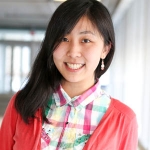 Not everyone realizes they’re destined for engineering at a young age, but Fan Guo is glad she did.
Not everyone realizes they’re destined for engineering at a young age, but Fan Guo is glad she did.
“I was lucky enough that my parents always encouraged me when I showed an interest in science,” said Guo, who now studies electrical engineering.
In grade seven, her science teacher urged her to participate in National Engineering Week. Tasked with the relatively simple challenge of building a thermos, Guo’s interest became a spark that would ignite into passion.
“It was my first taste of what the world of engineering could be like,” said Guo. “I went again the second year and I decided this might be something I want to do in the future.”
Guo loves how engineering often involves collaborating with people from different disciplines and perspectives.
“The way I approach a problem could be very different from the way a person with a mechanical engineering background may approach a problem. But in the end, it’s all the same. We are all looking for a solution.”
Lauren Howe (IndE 1T6)
 Lauren Howe chose to study industrial engineering because of the diverse range of jobs she could pursue after graduation.
Lauren Howe chose to study industrial engineering because of the diverse range of jobs she could pursue after graduation.
“I think I have a pretty balanced mindset between an analytical thought process and being able to look at the bigger picture, and how actions can impact society,” she said, and that balanced mindset has helped her excel in more than just academics.
Currently, Howe is the In-Arena host for the Toronto Maple Leafs, as well as the Executive Vice President of the University of Toronto Sports and Business Association.
Howe was also named Miss Canada Teen in 2011. She asserts her main focus during the competition was on her studies and athletics, and that the same qualities that helped her win, such as drive, competitiveness and perfectionism, are also qualities that make a good engineer.
“When you pursue things that you are passionate about, that passion comes through and you will find success in whatever field you choose.”
Katlin Kreamer-Tonin (EngSci 1T6)
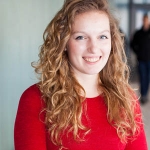 For Katlin Kreamer-Tonin, a third-year engineering science student with a biomedical specialization, engineering is an opportunity to see concrete results from her work.
For Katlin Kreamer-Tonin, a third-year engineering science student with a biomedical specialization, engineering is an opportunity to see concrete results from her work.
As a part-time research and development intern at Spinesonics Medical, she is helping create a new device to improve spinal fusion surgery.
“I think the most rewarding part [of engineering] is that you can can see the impact of your work,” she said.
Although she hasn’t completed her degree yet, Kreamer-Tonin is already experiencing the global opportunities that often materialize in engineering. This summer she is working on a 12-week research project at King Mongkut’s University of Technology Thonburi in Thailand, designing a smart home for the elderly.
“There are so many different opportunities if you are a young engineer,” said Kreamer-Tonin, who is 21 years old. “You can go in any direction you want to and you get to shape society and technology.”
She noted that it’s especially important for women to contribute as engineers because of how important diverse teams can be in engineering.
Jacqueline Murdock (ChemE 1T5)
 Jacqueline Murdock says she was always good at math and science, but what really attracted her to engineering was the opportunity to develop tools that can help her solve some of the world’s problems.
Jacqueline Murdock says she was always good at math and science, but what really attracted her to engineering was the opportunity to develop tools that can help her solve some of the world’s problems.
Murdock is now completing her fourth and final year in chemical engineering, but she is not the first engineer in her household. Her father is a chemical engineer as well.
“The apple doesn’t fall far from the tree,” said Murdock, laughing.
But as she pointed out, chemical engineering today offers much more diverse opportunities than when her father started his career.
“It’s not as straightforward as it was before.”
Nearing graduation, Murdock is excited to join the energy sector and contribute new methods to mitigate negative impacts on the environment. Initially, she aims to gain some technical experience, but eventually wants to tap into the policy side of engineering.
“You can have the technology and it can be a really great idea, but it needs to have funding and support to be able to grow.”
Parisa Najafi (MSE 1T6)
 While in her first year, materials science and engineering student Parisa Najafi was tasked with discovering why ice affects similar trees differently. As she examined the microscopic structures of birch and quaking aspen, Najafi developed a fascination of the natural world that has informed her education ever since.
While in her first year, materials science and engineering student Parisa Najafi was tasked with discovering why ice affects similar trees differently. As she examined the microscopic structures of birch and quaking aspen, Najafi developed a fascination of the natural world that has informed her education ever since.
“Nature makes the best classroom,” she said. “It’s hands-on, it’s dynamic, and its designs are usually more elegant and efficient than our own. Lucky for us, nature hasn’t patented anything yet.”
Inspired by her environment, Najafi, now in her third year of studies, pursued an opportunity as a research associate with nanOntario, an outreach program aimed at teaching high school students about bio-inspired technologies. The program brings nature into the classroom as both a teaching tool and an inspiration for students.
“We have the responsibility as engineers to think critically about these issues because we have the skills to innovate and drive positive change.”
Nataliya Pekar (TrackOne 1T7)
 As someone who tends to enjoy a range of academics, Nataliya Pekar was initially undecided about what she wanted to do in school. Ultimately, she chose engineering because she saw it as an opportunity to design and make real-world change to systems and infrastructure.
As someone who tends to enjoy a range of academics, Nataliya Pekar was initially undecided about what she wanted to do in school. Ultimately, she chose engineering because she saw it as an opportunity to design and make real-world change to systems and infrastructure.
“I just felt like I could make more tangible differences through engineering, especially in terms of sustainability,” she explained.
After completing Track One, a general first-year introduction to engineering, Pekar chose to pursue civil engineering.
“In certain engineering disciplines, you look at individual objects or designs. But in civil engineering, I like that you are often designing an entire system, like a wastewater treatment plant or a system for all of the transportation in Toronto. It impacts so many different people, and you have to take into consideration so many different impacts and problems.”
She recently put her skills as an engineer to work at the Ontario Engineering Competition, taking home second place in the consulting category. Pekar and her team went on to compete in the Canadian Engineering Competition in St. John’s, Newfoundland and Labrador.
Yoko Yanagimura (MinE 1T6)
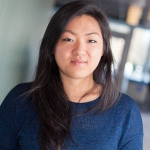 The thought of being an engineer didn’t cross Yoko Yanagimura’s mind at a young age.
The thought of being an engineer didn’t cross Yoko Yanagimura’s mind at a young age.
“All my life I thought I was going to be a biologist,” she said now.
She says a major reason for that is that not enough high school students are made aware of engineering as an option.
“When you’re in high school, you don’t learn about engineering. You learn about set subjects that don’t cover all of what you can study in university.”
After attaining her degree in her biology, Yanagimura decided to pursue studies in mineral engineering. She enjoys the ethical and social aspects of the job. Plus, she has a chance to significantly impact projects and be a part of an important process. She finds mineral engineering particularly exciting because this industry is “at the forefront of environmental management.”
“I can’t believe how much I love this,” said Yanagimura. “I wish I could have studied it earlier.”
Olesya Zhychkovska (CivE 1T6)
 Even though Olesya Zhychkovska’s father is an engineer, his career did not directly influence her career path.
Even though Olesya Zhychkovska’s father is an engineer, his career did not directly influence her career path.
“It was his character traits that inspired me,” she explained. “Not the engineering itself, but the kind of person he was.”
After gaining her father’s work ethic and passion for finding answers, Zhychkovska chose to pursue a degree in civil engineering.
“I don’t like to give up. If I’m challenged with something, I won’t give up until I find a solution.”
She says engineering is certainly challenging at times, but also rewarding. “Seeing results only encourages and motivates me to work harder,” said the 22-year-old.
Her advice to other young aspiring engineers is to, “Learn to be confident. If you know that this is truly what you want to do in life, then never let anything bring you down or make you divert from this path.”
Whether it’s swapping your car for an electric vehicle, or your natural gas furnace for geothermal heating, transitioning from fossil fuels to electric-powered technology is widely believed to be the best way to lower carbon emissions.
But according to U of T civil engineer Chris Kennedy (CivE), knowing where the electricity comes from to power those “eco-alternatives” is critical. If that electricity comes from burning oil and coal, it might mean that green alternatives aren’t that green after all.
Kennedy’s study, published in the journal Nature Climate Change, proposes a new decision-making threshold for when to move from fossil fuel technology to electric power (called electrification), and at what point that move may increase or lower carbon emissions.
Although regions may welcome “green” technology like electric vehicles, high-speed rail and geothermal heating, they aren’t green if the electricity to power them creates even more carbon emissions than their oil-driven counterparts.
For electrification to lower emissions, Kennedy says that a region needs to produce its electricity at a rate below his threshold: approximately 600 tons of carbon dioxide equivalent per gigawatt hour (GWh). This means that for every gigawatt hour of electricity generated (the power needed to run about 100 homes for a year), less than 600 tons of greenhouses gases (measured as “CO2 equivalent”) can be emitted.

If a region’s electricity production exceeds this 600-ton threshold, such as in countries like India, Australia and China (as shown below in Figure A), electrification could actually increase carbon emissions and accelerate climate change.
Countries such as these generate much of their electricity using coal, which he says produces about 1,000 tons of CO2 equivalent per GWh—nearly double the suggested threshold. Natural gas, on the other hand, produces 600 tons, and hydropower and nuclear energy produce nearly zero.
“You could speculate that incorporating electrified technologies such as high speed rail in China may not lower overall emissions,” says Kennedy. “It might even be more carbon friendly to fly.”
Kennedy employed an industrial ecology approach to dig into the data from four previous studies—including one from the International Energy Agency and others from Canada, the U.S. and countries in Europe.
As a nation, Canada’s electricity does not produce very much carbon in comparison to other regions. It ranks low on the list, at just under 200 tons of CO2 equivalent per GWh. “Despite that many believe our power is generated using fossil fuels from Alberta, most of Canada’s electricity mix comes from hydropower and nuclear facilities,” Kennedy says.
But when he zoomed in on certain regions in Canada, some of this good news changed. In a previous study, he compared the use of “green” geothermal heat pumps (used in homes) versus natural gas furnaces across different provinces. He found that the pumps were more eco-friendly in Ontario and British Columbia—owing to nuclear and hydropower—but in coal-dependent Alberta, it was greener to stay with a natural gas furnace.
In his recent paper, Kennedy also cites a study that found using plug-in electric vehicles emitted less carbon when used along the west coast of the United States, but produced the same, if not more, carbon when used in the Midwestern U.S.
Why does this threshold matter?
“Looking at overall carbon emissions of one country or a group of countries can only get you so far,” says civil engineering PhD student Lorraine Sugar (CivE MASc 1T0, PhD 1T8), who worked as a climate change specialist for the World Bank for nearly five years. “It’s hard to track progress and set goals internationally, while holding regions accountable. Having a specific and measurable target like this threshold is incredibly important, especially leading into the United Nations Climate Change Conference in Paris later this year.”
According to Kennedy, this threshold puts a marker down in a policy arena where none has existed before—and it isn’t just valuable for government.
“It reframes part of the climate change debate by encouraging individuals around the world to better understand where their electricity is coming from before they adopt supposedly eco-friendly technologies,” he says. “And even more, it incites them to understand how much carbon is emitted during the entire life cycle of those technologies—from their ongoing operation to their manufacture and disposal.”
He recommends people search for their local government energy agencies to find out how electricity is generated. If it is largely coal, then electric-powered technologies like ground-source heat pumps or electric vehicles may not be the most eco-friendly alternatives. On the national and international stage, he hopes governments do the same research when developing environmental policies and incentives.
“Canada’s three largest cities—Toronto, Montreal and Vancouver—have some of the lowest carbon emissions from electricity generation in the world,” says Daniel Hoornweg (CivE PhD), an associate professor at the University of Ontario Institute of Technology and a current U of T engineering PhD student.
“This threshold helps politicians make smarter energy decisions,” says Hoornweg, who recently retired from the World Bank after nearly 20 years in the urban sector. “Why aren’t we making better use of these advantages to electrify our transportation modes? And why are we so focused on one or two energy projects (like a pipeline) instead of working on a more comprehensive U.S.-Canada energy agreement that could better leverage our energy strengths?”
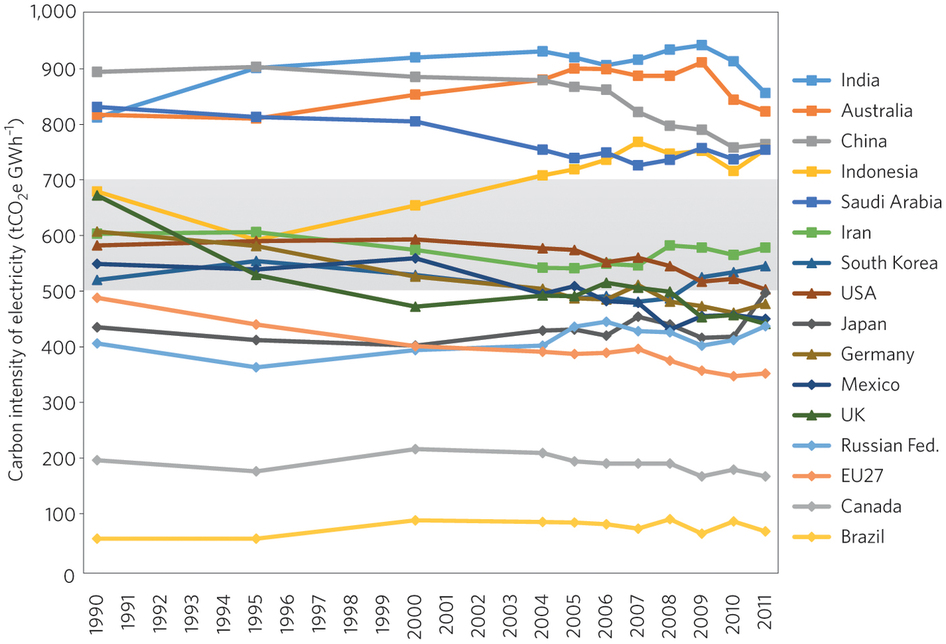
(Photos: Shutterstock, VinceFL, Vladimir Jovanovic, Watt Energy Saver)
Leading up to International Women’s Day on March 8, U of T Engineering is celebrating some of our remarkable female alumni, faculty and students. These women are inspirational role models who are “making it happen” in engineering and beyond.
Since 1873, U of T Engineering’s alumni community has grown to more than 50,000 worldwide, including innovators in medicine, sustainable energy, education and urban development.
Here are eight female alumnae who are making an impact on our world, from the outer reaches of the universe to the inner workings of the human brain. They are pushing boundaries and blazing a trail for generations of engineers to come.
Joelle Javier (MSE 1T0)
Engineer-in-Training, Technical Standards and Safety Authority
Not many engineers get to add “thrill-seeker” to their resume, but for Joelle Javier, it’s essential. As a safety specialist in amusement park rides for Ontario’s Technical Standards and Safety Authority (TSSA), she makes sure devices stand up to diehard adrenaline junkies.
“I get to imagine the worst thing a person could do to make the experience more fun,” she says. “I try to push the boundaries of the design, and then test it for safety.”
Javier reviews design submissions for new rides and inspects existing installations at the Canadian National Exhibition (CNE), Canada’s Wonderland and other parks. Relying on her knowledge of materials science—and especially her training in failure analysis at U of T—she pinpoints the potential causes of equipment malfunctions. She also meets with international committees to develop standards for the newest thrills, like zorbing and ziplining.
“The industry is growing and there are gaps in expertise,” she says. “In the future, I’d like to combine my skills and knowledge to design new rides.”
Catherine Lacavera (ECE 9T7)
Director of Intellectual Property Litigation, Google
She’s been called “Google’s secret weapon in the smartphone wars” and named one of Fortune Magazine’s 40 Under 40 for 2013. But before she became one of the tech industry’s most powerful women, attorney Catherine Lacavera got her start at U of T Engineering. She earned her B. Sc. in Computer Engineering in 1997, followed by an MBA and law degree, also at U of T.
Since she was hired at Google in 2005, she has led her legal team to victory in many multi-million dollar litigation matters in the U.S. and internationally, including Viacom’s copyright lawsuit against YouTube and the Apple, Microsoft and Oracle litigation directed at Android. She also advises on licenses and acquisitions, including the $12.5 billion purchase of Motorola Mobility. At any given time, she oversees more than 100 pending patent and intellectual property cases.
Loyal to her roots, Lacavera remains involved at ECE, serving on the faculty’s Board of Advisors since 2012.
Maryam Modir Shanechi (EngSci 0T4)
Assistant Professor, Ming Hsieh Department of Electrical Engineering, University of Southern California
Named one of Technology Review’s Top 35 Innovators under 35 for 2014, Maryam Shanechi ranks among the world’s most promising young brain researchers. She has been tapped to join the Obama BRAIN initiative, a $300 million brain mapping collaboration that has been compared to the Human Genome Project in scope.
A PhD graduate from MIT, Shanechi’s work with brain-machine interfaces combines technology with neuroscience to decipher the brain’s electrical signals, potentially allowing researchers to manipulate those signals to treat neuropsychiatric disorders like depression. It could also help paralyzed patients move robotic limbs using only their thoughts, and automate anesthesia using feedback from the brain during surgery.
She credits her undergraduate experience at U of T Engineering with giving her the tools to pursue her passion for neuroscience. “At U of T, I learned how to be an independent thinker and forge my own career path,” she says. “I got the best possible education as an undergrad, which prepared me well for graduate school at MIT.”
Camila Londono Ferroni (EngSci 0T7 + PEY, IBBME PhD 1T5)
PhD Candidate, Faculty of Applied Science & Engineering, University of Toronto
A pioneering researcher in cell migration, Camila Londono Ferroni is the first author of a foundational study published February 2014 in the Proceedings of the National Academy of Sciences (PNAS).
Londono’s team discovered that, much like strangers in a crowd, cells in groups communicate by pushing each other as they move. Interestingly, these pushes come together to create long-range communication, which means the cells do not need to be connected to each other to move as a single unit. Her research could change our understanding of how the body heals wounds, how cancer metastasizes and other biological processes.
“The next step would be to try to understand how to make cells move more efficiently,” she says.
Londono says she is excited by the possibilities offered by the field of biomedical engineering. “As the population gets older, there is more need for problems to be solved,” she says. “This field has so much new ground left to cover.”
Rachelle McCann (ChemE 1T2 + PEY)
Consultant, Compass Renewable Energy Consulting Inc.
Over the next 50 years, renewable energy sources are expected to supply most of the world’s electricity requirements. To help Ontario’s solar, wind and biomass power developers meet the growing demands of the sustainable energy market, engineering grads like Rachelle McCann are offering their technical expertise and problem-solving acumen.
McCann’s firm, Compass Renewable Energy, provides support for companies involved in the province’s Feed-in Tariff contracts, which allow renewable energy providers to sell power to the grid at fixed prices. Among her many responsibilities, McCann monitors a portfolio of solar ground mount projects to ensure the materials used meet local content standards.
Her passion for the environment drives her enthusiasm for the job, and she enjoys the wide range of challenging projects. “I never settle into the same way of thinking or solving problems,” she says. “This creates an interesting work environment.”
Natalie Panek (UTIAS MASc 0T9)
Mission Systems Engineer, MDA Robotics and Automation
An aspiring astronaut and passionate advocate for women in science, Natalie Panek takes a no-holds-barred approach to everything she does. Whether she’s designing spacecraft, trekking in Patagonia or building and racing a solar-powered car across North America, her enthusiasm for adventure is contagious.
With MDA’s Robotics and Automation division, which created the original Canadarm, Panek is helping develop the next generation of technologies to support Canadian and international space missions. Her project portfolio includes a robotic tool to repair and refuel broken satellites, reducing the amount of debris in orbit. “If we can use hardware that’s already up there, it makes space exploration more sustainable,” she says.
Named one of Forbes’ 30 Under 30 for 2015, Panek is a popular speaker on female empowerment. She is involved with Cybermentor, an online program through the University of Calgary that allows young women to ask questions and engage with female mentors in STEM fields.
Caroline O’Shaughnessy (MIE 1T0 + PEY)
M.D. Candidate, University of Toronto Faculty of Medicine
As an undergraduate in Mechanical and Industrial Engineering, Caroline O’Shaughnessy hadn’t originally considered a career in medicine. But when her extracurricular activities brought her into the world of first responders, she found her calling.
She started out as a volunteer with the University of Toronto Emergency First Responders, which began in 2006 as a small group of MIE students providing First Aid during Skule™ events (such as the famously full-contact Chariot Race). Eventually, they expanded their patrols to the entire campus, covering events and teaching CPR.
O’Shaughnessy credits her fellow Engineering students for their camaraderie, inclusiveness and work-hard, play-hard ethos. “It’s really easy to get involved, because everyone’s involved,” she says.
“Engineering teaches you how to think and work through problems,” she says. “I found that gave me a huge advantage in my clinical placements.”
Mary Alexander (CivE 1T3, MEng 1T4)
Structural Designer, Moses Structural Engineers
 Working alongside architects, Mary Alexander designs wood and timber constructions, providing engineering assistance on a variety of new projects. Her firm, Moses Structural Engineers, has been involved with some of Canada’s most innovative wood builds, such as the Art Gallery of Ontario (AGO) in Toronto and the TD Place Stadium in Ottawa.
Working alongside architects, Mary Alexander designs wood and timber constructions, providing engineering assistance on a variety of new projects. Her firm, Moses Structural Engineers, has been involved with some of Canada’s most innovative wood builds, such as the Art Gallery of Ontario (AGO) in Toronto and the TD Place Stadium in Ottawa.
Recent changes to Ontario’s building code allow wood and timber construction up to six storeys, ushering in a new era of desirable mid-rise buildings. “Wood is a lot faster to go up, it’s lighter, and there are significant cost savings,” Alexander says. “It’s also more eco-friendly—it has a net zero or negative carbon footprint.”
All this adds up to more demand for skills like Alexander’s. As an undergrad in Civil Engineering, she became interested in building science and chose to further specialize with an M. Eng. in Structural Engineering.
“I love what I do, it’s basically my dream job,” she says. “As our infrastructure ages, there are huge opportunities for new grads.”


